Traditional Polish soldra & white borscht with beluga
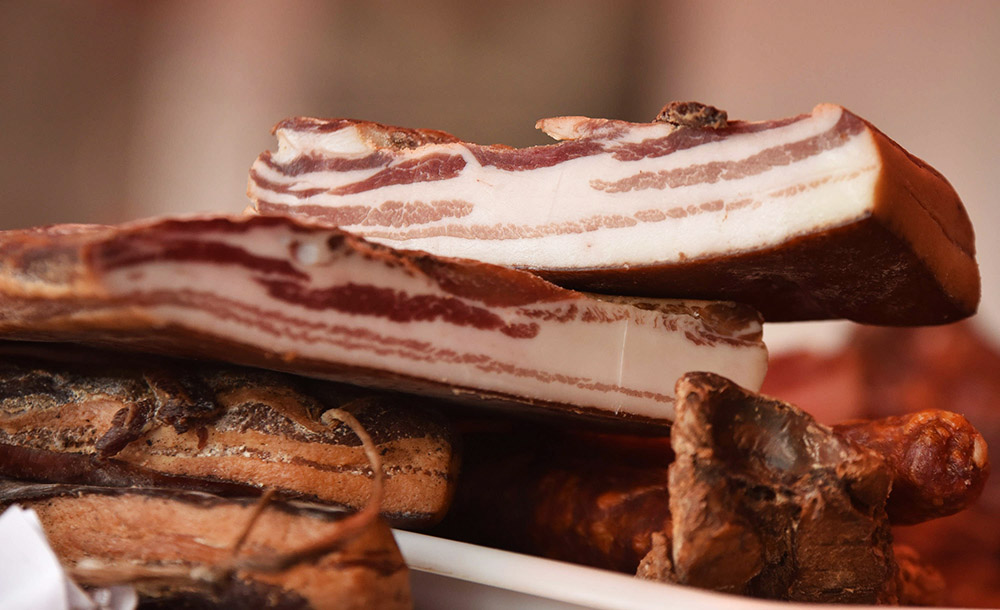 Smoked meat, photo: Hrvoje Jelavic / PIXSELL / PAP
Smoked meat, photo: Hrvoje Jelavic / PIXSELL / PAPFor centuries, certain animals would be killed before winter and salted, dried or smoked, to be consumed later. Polish poet Jan Kochanowski wrote that soldra (smoked ham or shoulder of pork) dried in the wind, or in thick smoke, tastes good in winter. Also, from his epigram To Poets, one can learn that smoked ham would sometimes be present on the table during the Polish Renaissance:
Don’t sniff at what my humble home has to offer,
I, like Chiron, live in the forest.
There will be cheese and soldra, there will be fragrant plums…
Smoked capon & smoked chopped spike
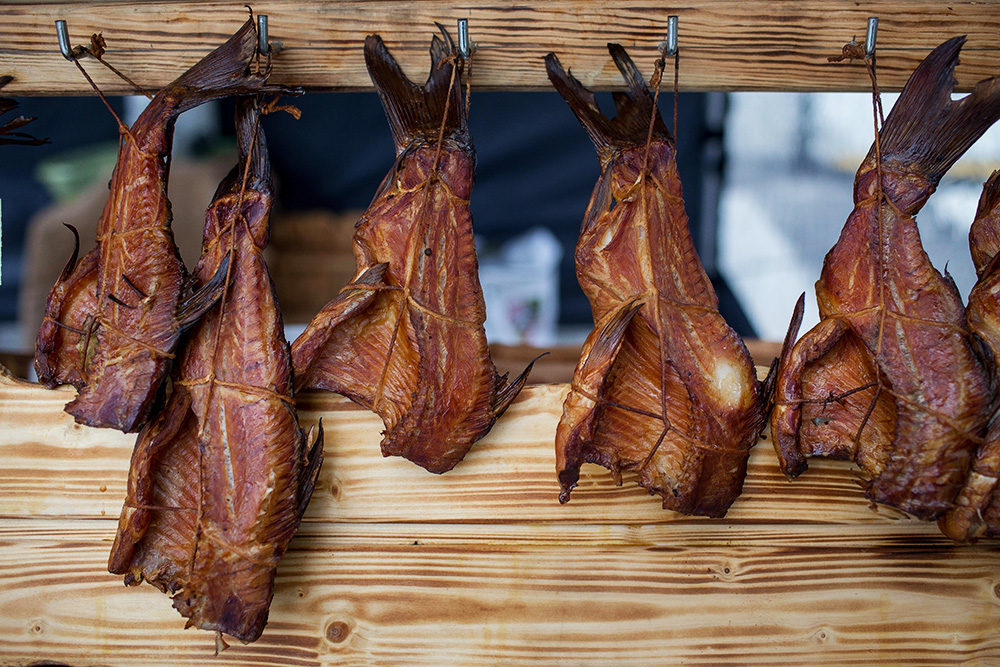 Smoked fish at a fresh produce market, Wrocław, photo: Maciej Kulczyński / PAP
Smoked fish at a fresh produce market, Wrocław, photo: Maciej Kulczyński / PAPAccording to Professor Jarosław Dumanowski, a researcher of old Polish cuisine, in the 17th century not only capon, veal or beef was used for making sausages in magnate cuisine but also fish, such as chopped pike. This was due, among other reasons, to the taboo around eating pork. Pork sausages were considered less sophisticated than those made of fish. Nevertheless, in the oldest Polish cookbook, written by Stanisław Czarniecki from the 17th century entitled Compendium Ferculorum, smoked soldra is mentioned as an indispensable element of every banquet and a tasty addition to other dishes.
There is also a recipe for smoked head cheeses (cold cuts) made of pork. Other smoked meats mentioned by Czarniecki include deer and wild boar. Here is a recipe for smoked game:
Having skinned your deer or having singed your boar, hack them into chunks which you will salt and put in a barrel, pressing it all with a weight. After several days, wash your chunks in fine water, hang them in warm smoke and smoke according to your need.
Borscht with smoked beluga
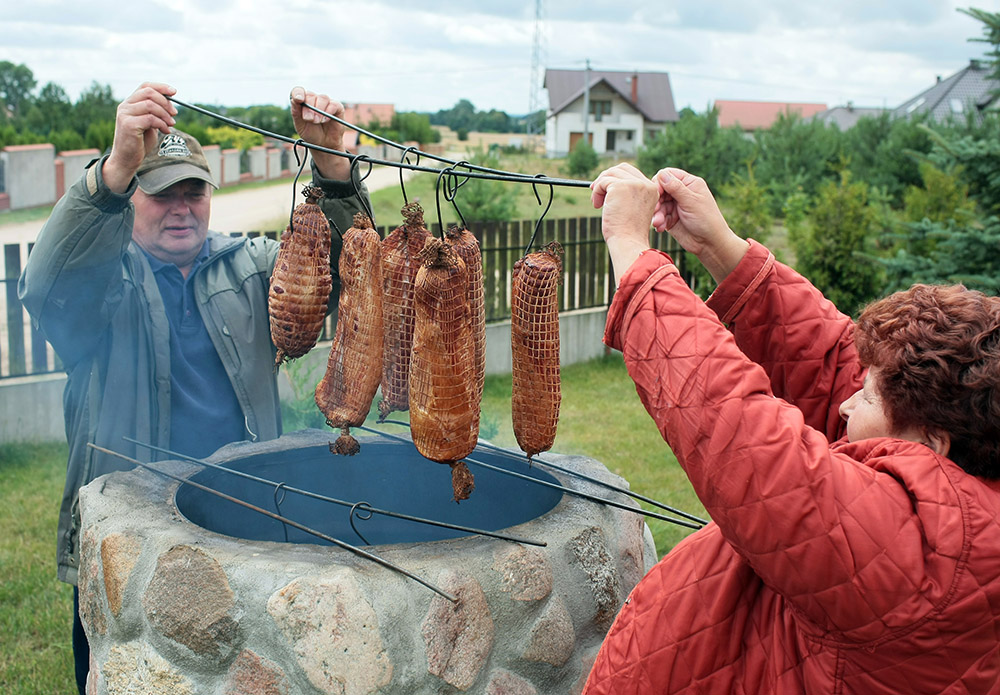 Smoking meat in a backyard smokehouse, photo: Piotr Mecik / Forum
Smoking meat in a backyard smokehouse, photo: Piotr Mecik / ForumIn Compendium Ferculorum one can also find mentions of smoked fish. Apart from sausages made of fish, Stanisław Czarniecki also mentions smoked sturgeon in the section of book entitled Fish Necessities:
The head of white or yellow smoked szczuka (pike), was an ingredient of a pottag, and smoked wyzina (beluga) was added to a borscht called ‘royal.’
This was a kind of rye bran borscht, with several kinds of fish, dried mushrooms, buckwheat groats, and cumin. And how do you smoke fresh sturgeon?
Scrape fresh sturgeon in strips or cut beluga in length-wise strips, no wider than a finger-and-a-half, put your fish in a dish and salt liberally, press down with a weight and after a few days rinse it in beer and hang in thick warm smoke. Being smoked, you can use it as you wish.
Goose smoked in a chimney
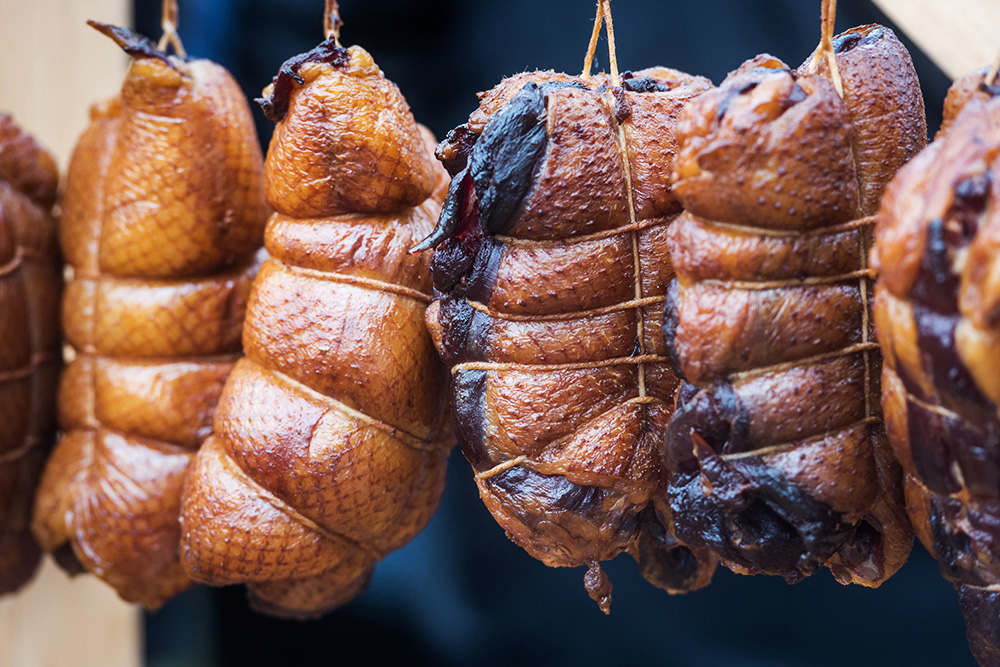 Goose breast Toruń-style, photo: Tytus Żmijewski / PAP
Goose breast Toruń-style, photo: Tytus Żmijewski / PAPIn his book The Perfect Cook, Wojciech Wielądko mentions ‘meats smoked in a chimney’: smoked gammon and sirloin, but also smoked goose breast, the so-called półgęski. Meat that was to be smoked was first placed in brine (now it is cured) and marinated for several days in a mixture of wine, spices and fragrant herbs: thyme, bay leaf, basil, marjoram and summer savoury.
After an appropriate time has passed, take the meat out of the mixture, let it dry a little and hang it in the smoking chimney. When ready, pour some wine and vinegar over it to preserve it, and cover it with ash…
As long as three years
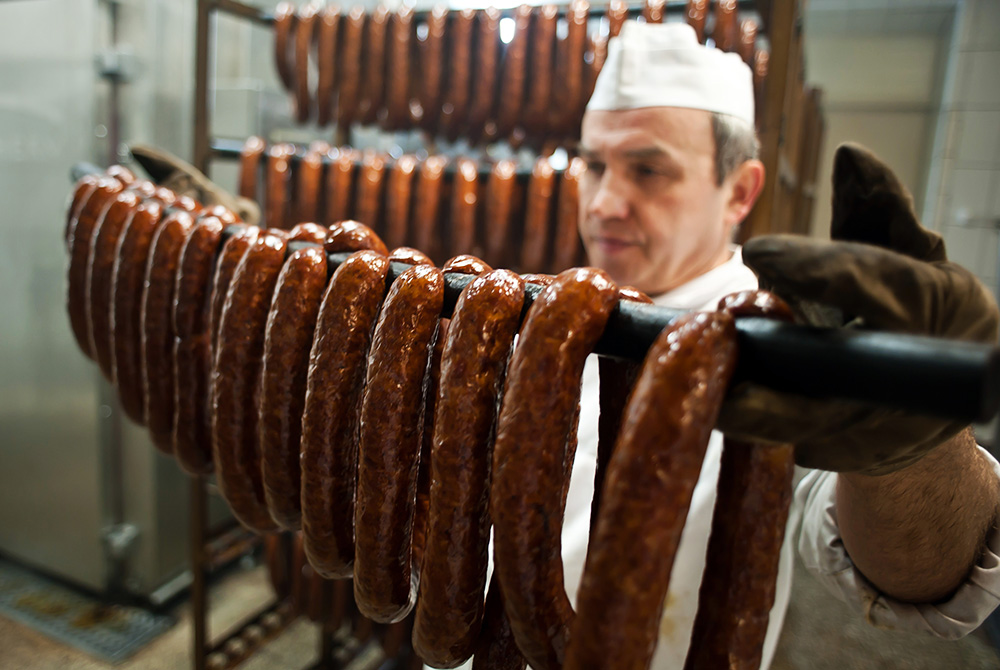 Bacówka – the biggest producer of traditional Polish smoked meats in Małopolska, photo: Wojciech Matusik/Forum
Bacówka – the biggest producer of traditional Polish smoked meats in Małopolska, photo: Wojciech Matusik/ForumIn other 18th- and 19th-century culinary publications, one frequently comes across smoked pork or beef tongues, which today are rarely served in this form. First, they were marinated with lots of spices and then smoked for several weeks. Smoked tongue is also mentioned in Compendium Ferculorum as an ingredient of the allaputry pâté. In Poland, even over 200 years ago, sausages were produced according to 24 different recipes.
Meats were smoked for a long time – larger pieces were smoked for as long as six weeks. ‘The slower the process and the colder the smoke, the better.’ Wood used for smoking shouldn’t be tarred or soft, but hard – like oak. At times, adding juniper wood was recommended. As a result, as we learn from other 18th-century recipes, smoked ham could be stored ‘without going bad or rotten’ for as long as three years.
Homemade vs. mass produced
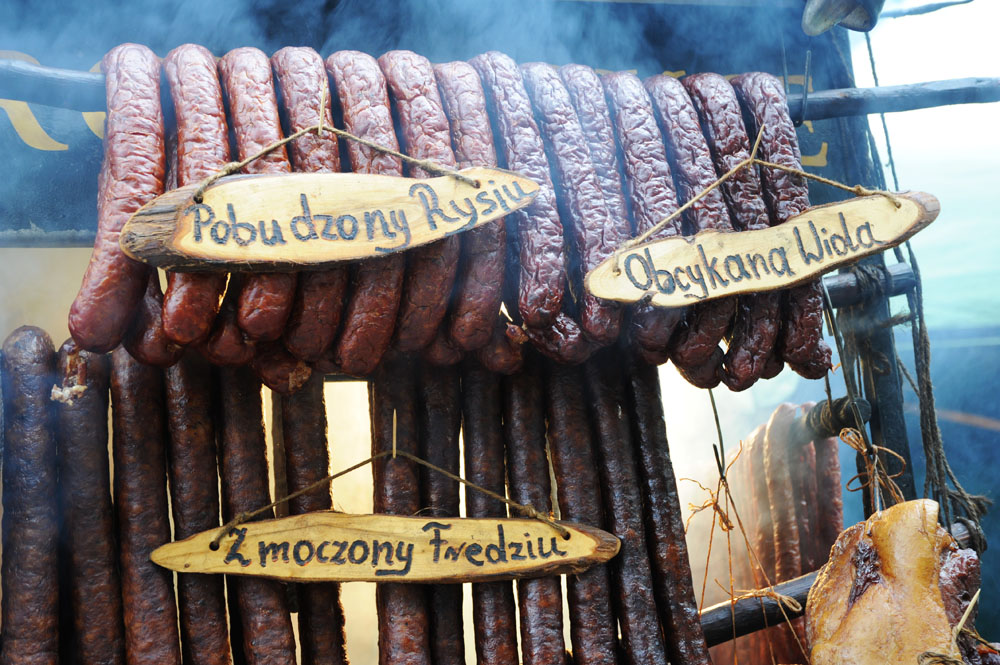 Smoked sausage, photo: Zenon Zyburtowicz/East News
Smoked sausage, photo: Zenon Zyburtowicz/East NewsAt the beginning of the 20th century, despite the development of the food industry, people appreciated the taste of traditional home-made products: sirloin, sausages, pork, veal and beef hams, head cheeses, brawn, liver sausages, goose breast and smoked ducks. Their qualities and exquisite taste, much better than mass-made products, were praised by old-time authors, such as Elżbieta Kiewnarska in her book Homemade Meat Products: Salting, Smoking, and Marinating Meat from 1928.
From Congress Poland, Lithuanian & Pomeranian, until today
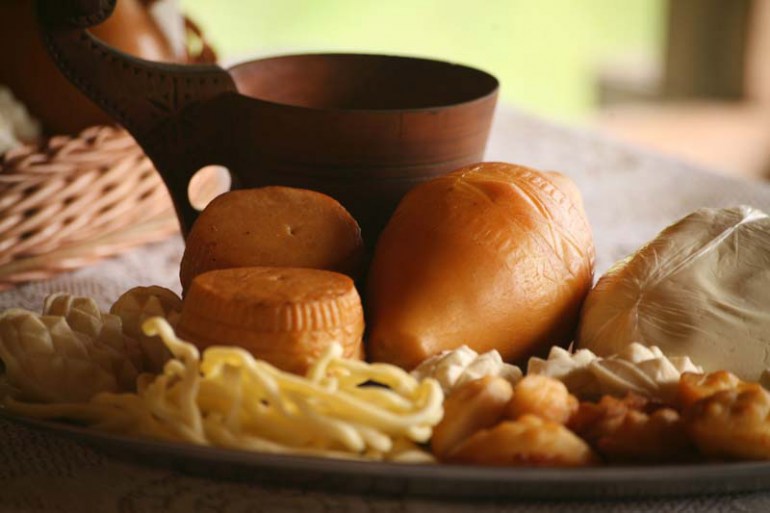 Making oscypek and bryndza in Małopolska, photo: Jola Lipka/East News
Making oscypek and bryndza in Małopolska, photo: Jola Lipka/East NewsIn inter-war Poland, cold cuts tasted differently depending on the region where they were produced. Kiewnarska writes:
In former Congress Poland, ham is smoked for a short time and cooked (…) Sausages and sirloin are also smoked lightly and they resemble charcuterie products made in towns. In Kresy, Volhynia and Małopolska, on the other hand, and also in Wielkopolska and Pomerania, they make smoked meats that last for a long time and may be preserved. Such meats are usually prepared in large quantities, during the winter months, when there are no flies or other vermin that may spoil the whole lot.
The longest-lasting and most highly-valued smoked meats came from Kresy, the Eastern Borderlands, and were known at the time as Lithuanian:
Frequently a big ham, hanging somewhere inside a granary, would be consumed three years after it was smoked. Its rind was hard as iron – it had to be well soaked in water before cutting – but when cut, the fat was pink, as in a freshly smoked one, and the meat was translucent, of dark red, cherry-like colour, and it could be cut into paper-thin slices – its taste was unparalleled.
Smoked meats from Pomerania were also highly valued – they resembled Lithuanian ones and successfully competed with those produced locally. What was the secret behind their durability? It was not just the manner of salting, marinating and spicing but first of all of smoking. The smoke used for meats had to be cold and the meat had to be hung very high – some five metres above the fire. It was smoked for a few hours in the morning and in the evening – in-between it dried without smoke.
A century later, a smoky flavour still remains one of the characteristic features of Polish cuisine. It can be found in contemporary dishes served in fine-dining restaurants and hip bars: you can find not just smoked fish, meat or cheese on your plate, but also smoked vegetables, eggs, cream, and even butter and ice cream!
Originally written in Polish, translated by MF, Aug 2017